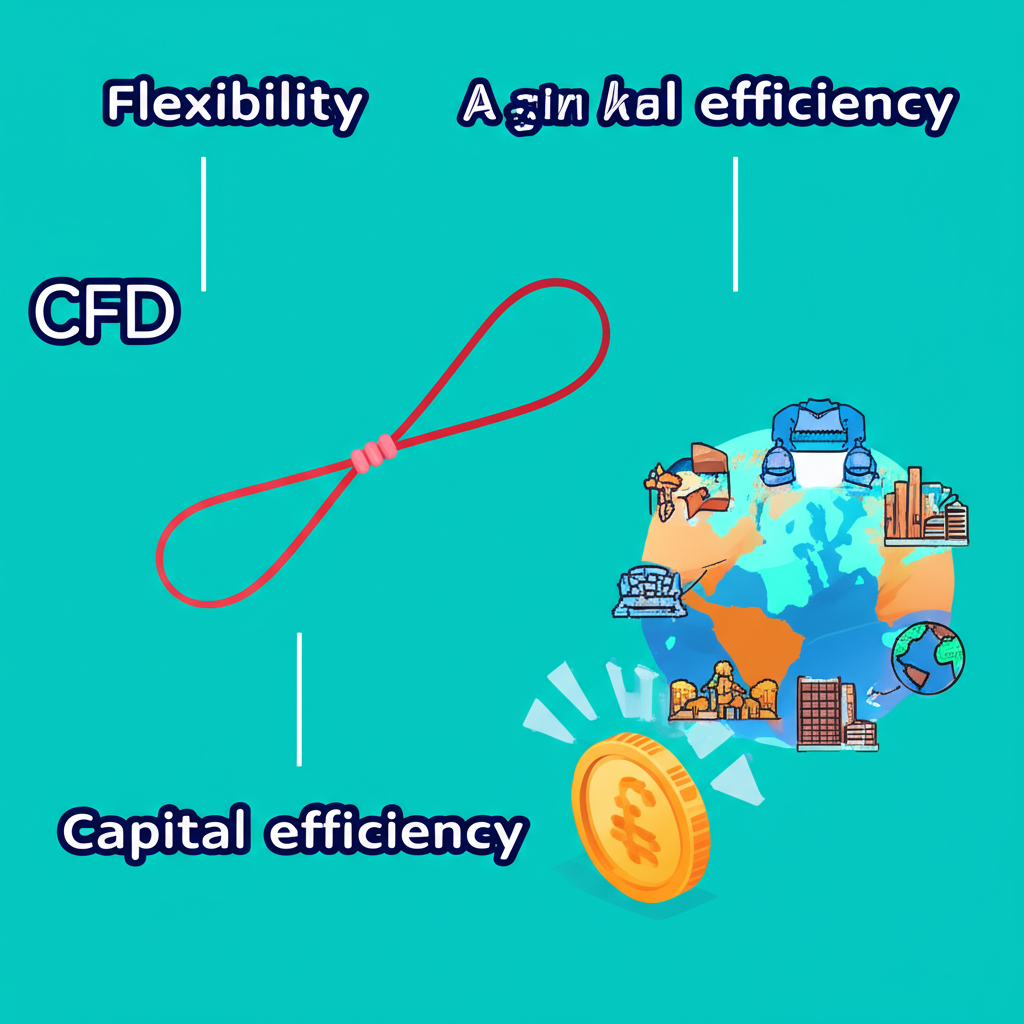Introduction: Understanding the Allure of CFDs

In recent years, Contracts for Difference (CFDs) have captured the attention of traders worldwide, carving out a distinct niche in the financial landscape. At its heart, a CFD is an agreement between a trader and a broker to settle the difference in an asset’s price from the moment a position opens to when it closes. This structure allows market participants to speculate on price movements across a broad spectrum of assets—without ever taking physical ownership. As more individuals explore active trading, a common question arises: what drives the appeal of CFDs? The answer lies in a unique combination of strategic flexibility, amplified market exposure, and the potential for significant returns—all balanced against a backdrop of equally substantial risks. This guide delves into the motivations behind CFD trading, examining the benefits that attract seasoned investors, the pitfalls that demand caution, and the regulatory frameworks shaping its global availability.
The Core Advantages: Why Traders Choose CFDs

CFDs stand apart from conventional investment tools by offering a level of agility and accessibility that appeals to modern traders. Their popularity stems from a few core strengths—leverage, directional flexibility, broad market reach, hedging utility, and cost-effective entry—that collectively redefine how individuals engage with financial markets.
Magnified Returns with Leverage: A Double-Edged Sword

Leverage is arguably the most defining feature of CFD trading. It enables traders to open positions significantly larger than their initial capital outlay, using what’s known as margin. For example, with a leverage ratio of 1:30, a trader can control a $30,000 position with just $1,000 of their own funds. This means even minor price fluctuations can generate outsized gains, making it an attractive tool for those aiming to maximize capital efficiency. However, the same mechanism that boosts profits can also accelerate losses. If the market moves against a leveraged position, the financial impact is proportionally greater. This inherent duality makes disciplined risk management non-negotiable—traders must be acutely aware that leverage amplifies outcomes in both directions.
Profit in Any Market: Going Long and Short
One of the most strategic advantages of CFDs is the ability to profit regardless of market direction. Unlike traditional stock investing, which typically relies on rising prices for gains, CFDs allow traders to take both long and short positions with equal ease. When a trader expects a market to climb, they can go long—buying a CFD in anticipation of higher prices. Conversely, if a downturn is expected, they can go short—selling a CFD first, then buying it back later at a lower price. This two-way market access is especially valuable during volatile or bearish periods, where opportunities still exist for those equipped to act. Whether responding to economic shifts or geopolitical events, traders can adapt quickly without being constrained by the limitations of asset ownership.
Unrestricted Market Access: Trade Across Global Asset Classes
CFDs open the door to a vast ecosystem of financial markets—all accessible from a single trading platform. Traders can engage with forex pairs, global indices like the S&P 500 or DAX, individual equities, commodities such as crude oil and gold, and even digital assets like Bitcoin and Ethereum. This breadth of access simplifies portfolio diversification, enabling traders to spread risk across regions and sectors. It also allows for rapid reaction to breaking news, earnings reports, or central bank decisions without the logistical hurdles of managing multiple brokerage accounts. For those seeking a unified, responsive trading experience, CFDs offer a powerful solution.
Hedging Existing Portfolios: A Risk Management Tool
Beyond speculation, CFDs serve a vital role in risk mitigation. Investors who hold physical stocks or ETFs can use short CFD positions to hedge against potential downturns. For instance, if a portfolio is heavily weighted in technology stocks and a sector-wide correction is anticipated, a trader might open short CFDs on key tech shares or a relevant index. Should the market decline, profits from the short positions can offset losses in the physical holdings, effectively preserving capital. This approach allows investors to maintain their long-term positions while protecting against short-term volatility—offering a tactical edge without the need for full liquidation.
Cost Efficiency: Lower Entry Barriers and Trading Costs
Compared to direct asset ownership, CFD trading often involves lower upfront costs and fewer transactional barriers. In many jurisdictions outside the United States, CFDs are exempt from stamp duty—a tax applied when purchasing physical shares. While some brokers charge commissions, especially on share CFDs, many instruments like forex and commodities are traded using spreads—the difference between the buy and sell prices. The margin-based system further reduces capital requirements, allowing traders to gain exposure to high-value markets with limited funds. That said, it’s important to account for overnight financing costs, which can accumulate over time and impact net returns, particularly on longer-held positions.
The Inherent Risks: Why Caution is Paramount When Trading CFDs
Despite their advantages, CFDs carry significant risks that demand careful consideration. The same features that offer opportunity—leverage, market access, and flexibility—can also expose traders to severe financial loss if not managed with discipline and expertise.
Leverage Risk: The Potential for Amplified Losses
While leverage can boost gains, it equally intensifies losses. A position that moves unfavorably can erode a trader’s margin rapidly, potentially triggering a margin call—where the broker demands additional funds to maintain the position. If the account balance falls below a critical threshold, the broker may automatically close positions to prevent further losses. In extreme cases, losses can surpass the initial deposit, especially in volatile markets. Regulatory reports, including those from the European Securities and Markets Authority (ESMA), consistently show that a high percentage—often between 70% and 80%—of retail traders lose money when trading CFDs, underscoring the dangers of undercapitalization and poor risk control.
Market Volatility and Gapping
Financial markets are inherently unpredictable, and CFDs, due to their leveraged nature, magnify the impact of sudden price swings. “Gapping” occurs when prices jump from one level to another without trading in between—common during major news events or after market closures. If a gap happens against an open CFD position, losses can be immediate and severe. Even stop-loss orders, designed to limit downside, may execute at a much worse price than intended, leaving traders exposed to slippage. This risk is particularly pronounced in fast-moving markets like forex or during economic announcements.
Overnight Funding Costs (Swaps)
Holding a CFD position overnight typically incurs a financing charge, known as a swap or rollover fee. This cost reflects the interest associated with the leveraged capital used to maintain the trade. Depending on the asset, trade direction, and prevailing interest rates, swap fees can be positive (crediting the account) or negative (debiting it). While small on a daily basis, these charges accumulate over time and can erode profitability—especially in long-term positions. Traders must factor in these costs when planning their strategies, particularly for extended trades.
Counterparty Risk
CFDs are over-the-counter (OTC) instruments, meaning they are private contracts between a trader and a broker rather than exchange-traded products. This introduces counterparty risk—the possibility that the broker may fail to meet its obligations. While reputable, regulated brokers undergo strict financial oversight and capital requirements, the risk remains. Choosing a well-regulated provider, such as one licensed by the FCA, ASIC, or CySEC, is essential to minimize exposure to this risk. Traders should verify regulatory status and review broker transparency before opening an account.
Who Benefits Most from CFD Trading?
CFD trading is not a one-size-fits-all strategy. It tends to resonate most with specific types of market participants who bring experience, discipline, and clear objectives to the table.
– **Experienced Traders:** Individuals with a strong grasp of technical and fundamental analysis, coupled with proven risk management practices, are better positioned to navigate the complexities of leveraged trading.
– **Short-Term Speculators:** Day traders and swing traders who aim to capitalize on quick price movements find CFDs ideal due to their speed, liquidity, and ability to go long or short.
– **Hedgers:** Investors with established portfolios can use CFDs to protect against short-term market declines without selling their underlying assets.
– **Diversifiers:** Those looking to gain exposure to multiple asset classes and global markets from a single platform benefit from the broad accessibility CFDs provide.
Conversely, CFDs are generally unsuitable for beginners, those with limited capital, or individuals with low risk tolerance. Without a solid understanding of leverage, margin, and market dynamics, the potential for significant losses increases dramatically.
Why Trade CFDs in Forex? A Specific Application
The foreign exchange market is one of the most popular arenas for CFD trading, and for good reason. Currency markets offer ideal conditions for leveraged speculation, and trading them via CFDs enhances accessibility and efficiency.
– **High Leverage:** Forex CFDs often come with higher leverage limits, enabling traders to control large positions with minimal capital.
– **24/5 Market Access:** The forex market operates around the clock from Sunday evening to Friday night, providing continuous trading opportunities across time zones.
– **Low Transaction Costs:** Most forex CFDs are traded on tight spreads with no additional commissions, making them a cost-effective way to engage with currency pairs.
– **Exceptional Liquidity:** As the largest financial market in the world, forex ensures rapid execution and minimal slippage, even during high volatility.
These attributes make CFDs a preferred vehicle for traders aiming to exploit currency fluctuations with precision and agility.
Regulatory Landscape: Why CFDs are Illegal in the US and Other Jurisdictions
Regulation of CFDs varies widely around the world, with some countries embracing them under strict rules, while others prohibit them entirely. Notably, CFDs are banned for retail investors in the United States. The Commodity Futures Trading Commission (CFTC) and the Securities and Exchange Commission (SEC) have long maintained that CFDs pose excessive risk due to their off-exchange nature, lack of transparency, and high leverage. The potential for retail traders to lose more than their initial investment is a primary concern, leading to a comprehensive ban.
Elsewhere, regulators have taken a different approach—allowing CFD trading but imposing safeguards. In the European Union, UK, and Australia, for example, leverage is capped for retail traders, and negative balance protection is mandated to prevent losses beyond deposited funds. These measures aim to preserve market access while reducing the likelihood of catastrophic outcomes.
CFDs vs. Other Trading Instruments: A Quick Comparison
To understand where CFDs fit in the financial ecosystem, it’s helpful to compare them with other common trading vehicles.
| Feature | CFDs | Traditional Stocks | Futures | Options |
| :——————– | :—————————————— | :——————————————- | :—————————————– | :——————————————— |
| **Ownership** | No physical ownership | Direct ownership of shares | Contract to buy/sell underlying asset | Right, but not obligation, to buy/sell |
| **Leverage** | High (magnifies both profit & loss) | Typically none (unless margin trading) | High | High (inherent leverage from price sensitivity) |
| **Short Selling** | Easy, often without borrowing restrictions | Can be complex, requires borrowing stock | Standard, selling futures contracts | Selling calls/buying puts |
| **Market Access** | Wide range of global assets | Primarily stocks, some ETFs | Specific commodities, indices, currencies | Wide range of underlying assets |
| **Costs** | Spreads, commissions (for shares), funding | Commissions, stamp duty | Commissions, exchange fees | Premiums, commissions |
| **Expiry** | Generally none (unless specified) | None (perpetual ownership) | Fixed expiry dates | Fixed expiry dates |
| **US Retail Traders** | Illegal | Legal | Legal | Legal |
Is CFD Trading Worth It? Making an Informed Decision
Whether CFD trading is worthwhile depends entirely on individual circumstances. For skilled traders with a disciplined approach, CFDs offer unmatched flexibility, global reach, and the potential for amplified returns. The ability to trade both rising and falling markets, combined with access to diverse asset classes, provides strategic depth that few instruments can match.
However, the risks are equally compelling. Leverage, while powerful, can lead to rapid losses. Overnight fees, market gaps, and emotional decision-making can undermine even the best-laid plans. Regulatory data consistently shows that most retail traders lose money—a sobering reminder of the challenges involved. Before diving in, it’s essential to assess your risk tolerance, educate yourself thoroughly, and start with a demo account. Only risk capital you can afford to lose. According to Grand View Research, the global CFD market was valued at USD 6.9 billion in 2022 and is projected to grow, reflecting ongoing demand. But growth doesn’t guarantee success—only informed, cautious participation does.
Conclusion: A Powerful Tool, If Wielded Responsibly
CFDs are a sophisticated financial instrument that can enhance trading strategies when used wisely. Their strengths—leverage, directional flexibility, and access to global markets—make them appealing to experienced market participants. Yet, these same features carry significant risks that can lead to substantial losses if mismanaged. Traders in jurisdictions where CFDs are permitted must approach them with a clear understanding of leverage, funding costs, and volatility. Recognizing who benefits most from CFD trading—experienced speculators, hedgers, and diversifiers—is key to determining suitability. In markets like forex, CFDs offer a streamlined way to engage with currency movements. Ultimately, CFDs are not inherently good or bad—they are tools. Their value lies in how they are used. For those committed to education, disciplined risk management, and responsible trading, CFDs can be a valuable addition to a broader financial strategy. Without these safeguards, they can quickly become a source of significant financial strain.
What exactly is a Contract for Difference (CFD)?
A Contract for Difference (CFD) is a financial derivative that allows you to speculate on the rising or falling prices of fast-moving global financial markets, such as forex, indices, commodities, shares, and cryptocurrencies. When trading a CFD, you do not own the underlying asset; instead, you enter into an agreement with a broker to exchange the difference in the price of an asset from the time the contract is opened until it is closed.
How does leverage work in CFD trading, and what are its implications?
Leverage in CFD trading allows you to control a large position with a relatively small amount of capital (margin). For example, with 1:30 leverage, you can open a position worth $3,000 with just $100 of your own funds. While this can magnify potential profits from small price movements, it equally amplifies potential losses. If the market moves against your position, you can lose more than your initial deposit, leading to margin calls or even automatic closure of your positions.
Can I trade CFDs on any financial market?
CFDs offer access to a vast range of global financial markets. This typically includes:
- **Forex:** Major, minor, and exotic currency pairs.
- **Indices:** Global stock market indices like the S&P 500, FTSE 100, DAX 40.
- **Commodities:** Hard commodities (gold, silver, oil) and soft commodities (corn, wheat).
- **Shares:** Individual company stocks from major exchanges.
- **Cryptocurrencies:** Popular digital assets such as Bitcoin, Ethereum.
The specific markets available depend on your broker.
What are the primary risks associated with CFD trading?
The main risks include:
- **Leverage Risk:** Magnified losses, potentially exceeding your initial deposit.
- **Market Volatility:** Rapid and unpredictable price movements can quickly turn positions unprofitable.
- **Overnight Funding Costs (Swaps):** Fees incurred for holding positions open overnight, which can erode profits or deepen losses over time.
- **Counterparty Risk:** The risk associated with the CFD provider (broker) defaulting, as CFDs are OTC products.
Why are CFDs not allowed for retail investors in the United States?
CFDs are banned for retail investors in the United States primarily due to investor protection concerns by regulatory bodies like the CFTC. They are considered high-risk, off-exchange products with insufficient transparency and oversight compared to exchange-traded instruments. The high leverage and potential for significant losses, often exceeding the initial investment, are key factors in this prohibition.
Is it possible to lose more money than I deposit when trading CFDs?
Yes, it is possible to lose more than your initial deposit, especially in highly volatile markets or with significant leverage. While many regulated brokers offer negative balance protection (which caps your losses at your account balance), this is not universally guaranteed and depends on the broker and jurisdiction. Without such protection, rapid market movements against your position can lead to a negative balance in your trading account.
How do CFDs differ from traditional stock trading or futures?
Key differences include:
- **Ownership:** CFDs involve no ownership of the underlying asset, unlike traditional stock trading.
- **Leverage:** CFDs typically offer much higher leverage than traditional stock trading (without margin accounts).
- **Short Selling:** Shorting is generally easier with CFDs than with traditional stocks.
- **Expiry:** Most CFDs do not have fixed expiry dates, unlike futures and options contracts.
- **Cost Structure:** CFDs often use spreads, while stocks have commissions and futures have commissions and exchange fees.
Who is CFD trading best suited for?
CFD trading is best suited for experienced traders with a strong understanding of market analysis, robust risk management strategies, and sufficient capital. It’s often favored by short-term speculators looking to profit from rapid price movements and by investors who wish to hedge existing portfolios against market downturns. It is generally not recommended for beginners or those with a low-risk tolerance.
What are overnight funding costs (swaps) in CFD trading?
Overnight funding costs, also known as swap rates or rollover fees, are charges applied to CFD positions held open past a certain time (usually 5 PM EST) at the end of a trading day. These costs reflect the interest paid or received for the leveraged capital used to maintain the position. They can be positive (you receive interest) or negative (you pay interest) depending on the asset, direction of your trade, and interest rate differentials.
How can I manage risk effectively when trading CFDs?
Effective risk management is crucial for CFD trading. Key strategies include:
- **Using Stop-Loss Orders:** Automatically closes your position if the price reaches a predetermined level, limiting potential losses.
- **Proper Position Sizing:** Only risk a small percentage of your trading capital on any single trade.
- **Understanding Leverage:** Use leverage judiciously and only to the extent you are comfortable with the associated risk.
- **Continuous Education:** Stay informed about market conditions, economic news, and trading strategies.
- **Capital Management:** Only trade with capital you can afford to lose.
- **Negative Balance Protection:** Choose brokers that offer this feature if available in your jurisdiction.

留言